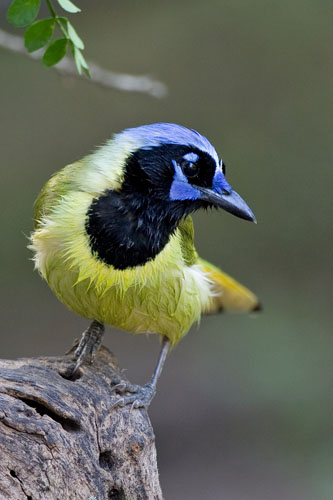
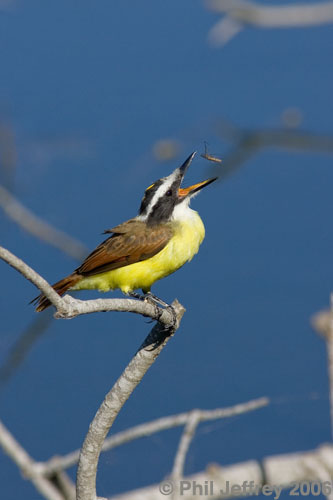

phil jeffrey:: Texas, Nov. 2006 trip report
 |
 |
After several years absence, I had planned to return to birding TX in spring 2006. That trip did not happen due to a rather entertaining illness that struck the morning I was intending to leave. Instead, I traveled to TX over the Thanksgiving holiday of 2006, flying on Thanksgiving itself and returning the following Tuesday.
This was the first time I came back to TX since late 2002. Since that time the Colorado and AZ-NM-CO trips helped put the Rio Grande Valley (RGV) experience into perspective. With most other trips you drive through the habitat and stop to watch birds. In the RGV you drive to the (remnant) habitat to see birds, since most of it has been eviscerated for agriculture or development. Despite the expansion of birding locations in the lower RGV, it's still mostly a suburban/agricultural birding experience sprinting between habitat fragments. It's a little like hitting places like Oscar Scherer State Park in Osprey on the west coast of FL. That having been said, you'd be hard-pressed to find a Green Jay on the west coast of FL.
November 2006 was in a quiet season for RGV rarities - the Northern Jacana had vanished two weeks before I made the trip so what there was around were the usual RGV specialities. The Seedeaters were still very elusive (better when they start singing, later in the "winter").
The ABA/Lane Guide to the RGV is rather out of date, although it's possible that the ABA/Lane Guide for the Upper Texas Coast (UTC) has been updated more recently (I had an older one). As a result I didn't even consult either of them and relied on memory, the directions in this page and on the Texas Birding Trail maps - hard copy they are a modest $3.15 each, and you can also download the information via the web (see below). Bentsen State Park only stocked the one for the lower Texas coast (not that smart), but Aransas NWR visitor center had all three.
(RGV = Rio Grande Valley)
| Least Grebe | Sabal Palm, Santa Ana | |||||||||
| Pied-billed Grebe | ||||||||||
| American White Pelican | Estero Llano, Port Aransas, Aransas NWR | |||||||||
| Brown Pelican | Port Aransas and UTC locations | |||||||||
| Neotropic Cormorant | Rio Grande River, Anahuac NWR | |||||||||
| Double-crested Cormorant | ||||||||||
| Anhinga | ||||||||||
| American Bittern | Brazoria NWR | |||||||||
| Great Blue Heron | ||||||||||
| Great Egret | ||||||||||
| Snowy Egret | ||||||||||
| Little Blue Heron | ||||||||||
| Tricolored Heron | ||||||||||
| Reddish Egret | Laguna Atascosa NWR, Brazoria NWR | |||||||||
| Cattle Egret | Bentsen NWR and nearby | |||||||||
| Black-crowned Night-Heron | Sabal Palm | |||||||||
| White Ibis | ||||||||||
| White-faced Ibis | Port Aransas, Anahuac NWR | |||||||||
| Roseate Spoonbill | Port Aransas, Anahuac NWR | |||||||||
| Black Vulture | ||||||||||
| Turkey Vulture | ||||||||||
| Black-bellied Whistling-Duck | Brownsville, Aransas NWR | |||||||||
| Greater White-fronted Goose | coastal RGV, Attwater NWR, Katy Prairie, Anahuac NWR | |||||||||
| Snow Goose | coastal RGV, Attwater NWR, Katy Prairie, Anahuac NWR | |||||||||
| Ross's Goose | Katy Prairie | |||||||||
| Canada Goose | Aransas NWR | |||||||||
| Cackling Goose | Katy Prairie | |||||||||
| Gadwall | ||||||||||
| American Wigeon | ||||||||||
| Mallard | Anahuac NWR | |||||||||
| Mottled Duck | Santa Ana NWR, Aransas NWR | |||||||||
| Blue-winged Teal | ||||||||||
| Cinnamon Teal | Anahuac NWR | |||||||||
| Northern Shoveler | ||||||||||
| Northern Pintail | ||||||||||
| Green-winged Teal | ||||||||||
| Redhead | ||||||||||
| Lesser Scaup | Attwater Prairie Chicken NWR | |||||||||
| Bufflehead | Attwater Prairie Chicken NWR | |||||||||
| Ruddy Duck | Anahuac NWR | |||||||||
| Osprey | ||||||||||
| White-tailed Kite | multiple in agricultural locations in the RGV | |||||||||
| Northern Harrier | ||||||||||
| Sharp-shinned Hawk | ||||||||||
| Cooper's Hawk | ||||||||||
| Gray Hawk | Bentsen State Park | |||||||||
| Harris's Hawk | multiple RGV locations | |||||||||
| Red-shouldered Hawk | Brazoria NWR, Anahuac NWR | |||||||||
| White-tailed Hawk | Port Aransas up to Attwater NWR | |||||||||
| Red-tailed Hawk | including at least two Krider's | |||||||||
| Crested Caracara | ||||||||||
| American Kestrel | ||||||||||
| Peregrine Falcon | Attwater Prairie Chicken NWR, (and Sabal Palm ?) | |||||||||
| Plain Chachalaca | RGV | |||||||||
| Wild Turkey | Aransas NWR | |||||||||
| Northern Bobwhite | Attwater NWR, Katy Prairie | |||||||||
| Common Moorhen | ||||||||||
| American Coot | ||||||||||
| Sandhill Crane | fields near Aransas NWR | |||||||||
| Whooping Crane | Aransas NWR | |||||||||
| Black-bellied Plover | ||||||||||
| Killdeer | ||||||||||
| Black-necked Stilt | Port Aransas, Anahuac NWR | |||||||||
| American Avocet | Santa Ana NWR, Port Aransas | |||||||||
| Greater Yellowlegs | Anahuac NWR | |||||||||
| Lesser Yellowlegs | Port Aransas | |||||||||
| Spotted Sandpiper | Rio Grande River | |||||||||
| Long-billed Curlew | Laguna Atascosa NWR, Katy Prairie | |||||||||
| Least Sandpiper | Anahuac NWR | |||||||||
| Dunlin | Anahuac NWR | |||||||||
| Long-billed Dowitcher | Anahuac NWR | |||||||||
| Wilson's Snipe | Brazoria NWR, Katy Prairie, Attwater NWR | |||||||||
| Laughing Gull | ||||||||||
| Ring-billed Gull | ||||||||||
| Herring Gull | ||||||||||
| Caspian Tern | ||||||||||
| Royal Tern | Aransas NWR and Laguna Atascosa NWR | |||||||||
| Forster's Tern | ||||||||||
| Rock Pigeon | ||||||||||
| Eurasian Collared-Dove | RGV | |||||||||
| White-winged Dove | Bentsen State Park, Laguna Atascosa NWR | |||||||||
| Mourning Dove | ||||||||||
| Inca Dove | RGV | |||||||||
| Common Ground-Dove | RGV | |||||||||
| White-tipped Dove | RGV | |||||||||
| Green Parakeet | Brownsville (Ft Brown) | |||||||||
| Common Pauraque | Sabal Palm | |||||||||
| Buff-bellied Hummingbird | Frontera Audubon Thicket | |||||||||
| Ringed Kingfisher | Estero Llano, Bentsen, Salineno | |||||||||
| Belted Kingfisher | ||||||||||
| Green Kingfisher | Estero Llano, Bentsen | |||||||||
| Golden-fronted Woodpecker | RGV | |||||||||
| Yellow-bellied Sapsucker | Bentsen NWR | |||||||||
| Ladder-backed Woodpecker | RGV | |||||||||
| Pileated Woodpecker | Brazoria County on UTC | |||||||||
| Northern Beardless-Tyrannulet | Bentsen NWR | |||||||||
| Eastern Phoebe | ||||||||||
| Vermilion Flycatcher | Estero Llano | |||||||||
| Great Kiskadee | RGV | |||||||||
| Couch's Kingbird | Sabal Palm, Bentsen, Santa Ana | |||||||||
| Scissor-tailed Flycatcher | Laguna Atascosa NWR | |||||||||
| Loggerhead Shrike | ||||||||||
| White-eyed Vireo | ||||||||||
| Blue-headed Vireo | RGV | |||||||||
| Green Jay | RGV | |||||||||
| American Crow | UTC only | |||||||||
| Chihuahuan Raven | Sabal Palm | |||||||||
| Black-crested Titmouse | RGV | |||||||||
| Carolina Wren | Sabal Palm | |||||||||
| House Wren | ||||||||||
| Sedge Wren | Brazoria NWR | |||||||||
| Marsh Wren | Port Aransas | |||||||||
| Golden-crowned Kinglet | RGV | |||||||||
| Ruby-crowned Kinglet | ||||||||||
| Blue-gray Gnatcatcher | ||||||||||
| Eastern Bluebird | Katy Prairie | |||||||||
| Clay-colored Robin | Santa Ana NWR, Bentsen State Park | |||||||||
| American Robin | Laguna Atascosa NWR, Aransas NWR | |||||||||
| Gray Catbird | ||||||||||
| Northern Mockingbird | ||||||||||
| Long-billed Thrasher | Santa Ana NWR, Bentsen State Park | |||||||||
| Curve-billed Thrasher | La Joya's sparrow road | |||||||||
| European Starling | ||||||||||
| Sprague's Pipit | Attwater Prairie Chicken NWR | |||||||||
| Orange-crowned Warbler | common in RGV | |||||||||
| Nashville Warbler | San Ygnacio Bird/Butterfly sanctuary | |||||||||
| Yellow-rumped Warbler | ||||||||||
| Black-and-white Warbler | various RGV | |||||||||
| Common Yellowthroat | ||||||||||
| Wilson's Warbler | Sabal Palm, Bentsen, San Ygnacio | |||||||||
| Olive Sparrow | (heard only - omitted from year list) Bentsen State Park | |||||||||
| Cassin's Sparrow | La Joya sparrow road | |||||||||
| Field Sparrow | Attwater NWR | |||||||||
| Vesper Sparrow | Attwater NWR | |||||||||
| Lark Sparrow | La Joya sparrow road | |||||||||
| Savannah Sparrow | ||||||||||
| Le Conte's Sparrow | Katy Prairie along Morrison Rd | |||||||||
| Song Sparrow | La Joya sparrow road | |||||||||
| Lincoln's Sparrow | RGV | |||||||||
| Swamp Sparrow | Brazoria NWR | |||||||||
| White-crowned Sparrow | Attwater NWR | |||||||||
| Northern Cardinal | ||||||||||
| Pyrrhuloxia | La Joya sparrow road | |||||||||
| Indigo Bunting | Bentsen State Park | |||||||||
| Red-winged Blackbird | ||||||||||
| Eastern Meadowlark | ||||||||||
| Great-tailed Grackle | abundant in RGV | |||||||||
| Brown-headed Cowbird | ||||||||||
| Altamira Oriole | Dewinds' at Salineno, Bentsen State Park | |||||||||
| Audubon's Oriole | Dewinds' feeders at Salineno | |||||||||
| Lesser Goldfinch | San Ygnacio Bird/Butterfly Sanctuary | |||||||||
| House Sparrow | ||||||||||
| Totals | 152 species |
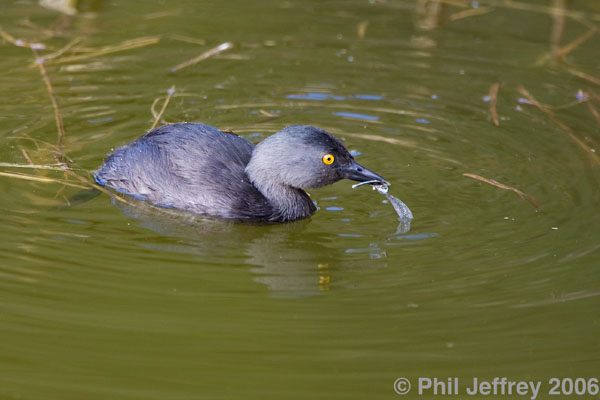
Least Grebe at Sabal Palm
I left Sabal Palm and Brownsville and took US-77 and US-83 to Weslaco were I stopped at the Estero Llano Grande WBC site at ~11am - a first time for me since it had opened since 2002. A Harris's Hawk and American White Pelicans were flyovers in the parking lot. Common Ground-Doves and Inca Doves were near the visitor center. I checked in at the visitor center and were told by other birders that there were Green Kingfishers at the Alligator Pond. After a little trek I found that the two trail branches did not connect (not a good design) so I had to backtrack to finally reach Alligator Pond. After a little while a Kingfisher bonanza ensued with two Ringed Kingfishers, a Belted Kingfisher and my hitherto nemesis species Green Kingfisher - good looks at all of them (including both genders of Green and Ringed) and all of them vocalized. Vermilion Flycatchers were also around the Grebe and Alligator Ponds. The Northern Jacana had not been reported in a week or two so I didn't waste my time looking for that one.
Leaving Estero Llano I stopped briefly in the early afternoon at another new site for me - Frontera Audubon thicket which is a relatively compact but well-designed location embedded in suburban Weslaco, and usefully had Buff-bellied Hummingbird at the visitor center feeders and the usual suspects on the trail: Green Jay, White-tipped Dove, Inca Dove, Black-crested Titmouse, Orange-crowned Warbler, Ruby-crowned Kinglet. The blind overlooking the lake had a restricted view so I did not see a Green Kingfisher that is often reported there. Inquiring about Red-crowned Parrots I was told that they had no set roosting site in the vicinity. This was to become a familiar theme.
In the mid-afternoon I went on to Santa Ana NWR, which hasn't changed very much since I last saw it - the vital soda machine has vanished, however. Santa Ana, like Sabal Palm, was relatively lush with much green grass and water in all the ponds. On the Willow Lake there was nothing except Coots and two Least Grebes. The Willow Lake trail was replete with mosquitos and nothing much except a distant Chachalaca call. Walking up the road toward the old manager's residence I came across a Clay-colored Robin in the parking lot and quite a lot of activity around the new hawk watch tower - Couch's Kingbird, Great Kiskadee, Plain Chachalaca, Long-billed Thrasher and another or the same Clay-colored Robin. The flycatchers in particular were numerous. Out at Pintail Lake(s) things were more active with Mottled Duck, Northern Shoveler, Blue-winged Teal, American Avocet, Roseate Spoonbill and various herons. Harris's Hawks were amongst the fly-overs.
I left Santa Ana NWR with just enough time to make it along US-281 back to Brownsville to look for Parrots. And it was only just, with the sun starting to set in my rear-view mirror as I reached Brownsville. I passed some Amazonia parrots on a wire in the general Honeydale/Los Ebanos neighborhood but had nowhere to pull off in the middle of traffic. Out at Fort Brown I discovered the hotels had been converted into a college dorm and street parking had been somewhat reduced but was able to locate a large Green Parakeet flock with ease along the road as they swarmed noisily around the palms. I failed to find Red-crowned Parrots just after sunset in the Los Ebanos neighborhood in Brownsville, however.
I stayed overnight at a Super 8 in Harlingen near the US-77/US-83 location - this makes more sense than to stay in Brownsville because it's about 15-20 miles closer to Weslaco and McAllen. Weslaco would probably be even better unless you were very Brownsville-centric.
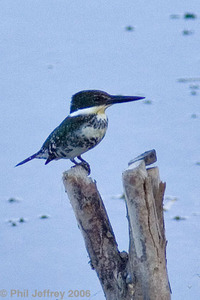 | Nevertheless in the early morning there were some upsides: Northern Beardless-Tyrannulet calling along the entrance road and giving good looks, along with the usual Orange-crowned/Gnatcatcher/Kinglet combination. A White-winged Dove flew over. Green Jays, Plain Chachalacas, White-tipped Doves were at the feeding stations. A Long-billed Thrasher came into a shady drip. A few Javelina wandered around. I saw a departing Gray Hawk on the outer circle near the resaca overlook. At that overlook a female Green Kingfisher came by and perched fairly close - inevitable that I would see one here after my life bird the previous day. By 10am most activity had diminished, especially along the entrance road. An Olive Sparrow or two sang but I never did manage to see it. Perhaps the biggest marker of how far Bentsen has fallen - I saw all of two Orioles - a distant pair that were probably Altamira. I think I could guarantee 10-20 on any previous visit there. The species I saw in my two visits to Bentsen on this trip seem to be fairly representative of what was being reported there. Common Pauraques are probably still findable after dark, although since I had flushed two at Sabal Palm I did not come back to search for them at dusk at Bentsen (the traditional place to look for them). |
Development near Bentsen includes a new trailer park and a housing complex along the palm-lined road heading south toward the park. How much this introduces predators (i.e. cats) to the park remains to be seen.
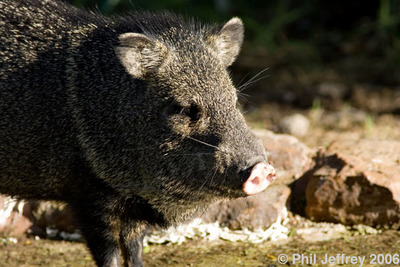
Javelina at Bentsen
After the highs and lows of Bentsen I decided to head west and north further up the Rio Grande. After the requisite 50 mile schlep through Rio Grande City, Roma and Zapata I wound up at the San Ygnacio Bird and Butterfly Sanctuary where I inevitably failed to find any Seedeaters. Nevertheless this is a good little site with feeders near the entrance (Hooded/Orchard Oriole females scattered as I approached), food dispersed around the trails, and a drip near the observation tower that pulled in Orange-crowned, Nashville, Yellow-rumped and Wilson's Warblers plus a pair of Lesser Goldfinches (black-backed male) along with the usual suspects. Typical RGV species like Green Jay, Plain Chachalaca and White-tipped Doves were also around. A male oriole that bolted into cover too quickly for me to get a good look at it was probably a Hooded.
Tracking back down the river I stopped at Salineno and for the first time at the Dewinds' feeders there. They joked that I was joining them to "watch grass grow" but fairly soon an Audubon's Oriole came in to feed, and later on an Altamira Oriole did the same thing. More persistent birds were Orange-crowned and Yellow-rumped Warblers, White-tipped and Inca Doves, Green Jays. A Northern Harrier made a pass at the birds but the opening in the canopy was just too small for it to impersonate an accipiter. A Crested Caracara flew over. Down at the river and pair of Ringed Kingfishers worked the edge, American Wigeons and Coots were in the river, Double-crested and Neotropic Cormorants were on the far side of the river and also few by. Spotted Sandpipers flew between the banks.
Leaving Salineno in the mid-late afternoon I decided to look for parrots in McAllen - this was a complete failure with nothing audible or visible around the Convention Center or in surrounding neighborhoods. After dark and after giving up in McAllen I returned to Harlingen and the Super8 for the night.
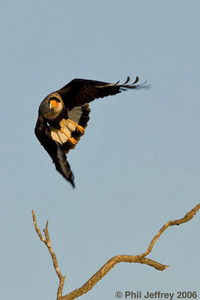 | After that start I went up to the "sparrow road" north-west of La Joya and found it to be the same as years past with many sparrows perched on the wires. Harris's Hawk, Crested Caracara and a Sharp-shinned Hawk were hunting over the scrub - the Harris's Hawk posed for photos but the Caracaras were not pleased to see me. Lark Sparrows, Savannah Sparrows and Song Sparrows were relatively easy to find. There was a single Pyrruloxia. The best place, as ever, was at the northern end of the tall new wire fence around the pastures - at this point there were many sparrows (including House Sparrow) and a single Cassin's Sparrow in the mix. A Curve-billed Thrasher perched up in the scrub to give me my only one for the trip. The only downside of this location is that the sparrows are somewhat silhouetted at dawn when perching on the wire fence, but the numbers remain good. Weekends are better than weekdays since the truck traffic is much reduced. The road is well graded but you can't pull off it well so the trucks hurtle by at 40 mph and kick up quite a bit of dust - much of which lingers on the roadside foliage. |
A little cloud started to move in so I decided to go to Bentsen (15 minutes away) for some photography before it completely clouded over. At Bentsen the entrance road was not as active (no Tyrrannulet) but the first feeder station beyond the old entrance station held a single Clay-colored Robin and a lot of activity at the drip (Indigo Bunting, Wilson's and Orange-crowned Warblers). After the activity quieted I went on to the resaca overlook where there was Ringed Kingfisher, Couch's Kingbird, Northern Harrier, Osprey, American Kestrel. I managed to get a few pictures of the "usual suspects" (Chachalaca, Green Jay) but nothing special was happening. Two Caspian Terns flew by as I returned to the parking lot - at this point the cloud cover had reached 80%.
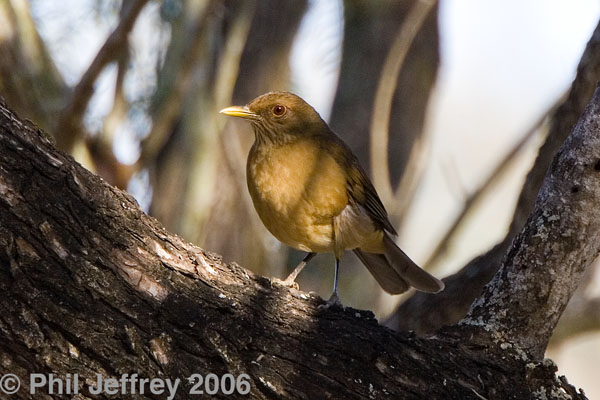
Clay-colored Robin at Bentsen
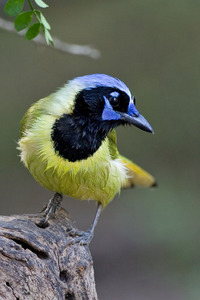 | I headed east on US-83 and then TX-160 past Harlingen toward the coast and to Laguna Atascosa NWR where there was a Scissor-tailed Flycatcher on the wires along the entrance road. The brisk breeze kept the passerines down along the auto route but there were herons all over the place along the bay including a white morph Reddish Egret. Caspian, Forster's and Royal Terns milled around. Two Long-billed Curlews were feeding amongst the herons and White Ibis. There were no signs of any Aplomado Falcons but Harris's Hawk and Crested Caracara were in evidence. The visitor center blind/feeder station was fairly active with the usual RGV species (Green Jay, White-tipped Dove) and also an American Robin flock and a White-winged Dove. |
A late-day run at Sabal Palm sanctuary showed the feeders to be dead with absolutely nothing at them (and light no better than in the morning). The Least Grebes at the resaca blind posed a little, but it was exactly the same species as the visit on Friday. I left the reserve within 45 minutes to head into downtown Brownsville.
Rummaging around Brownsville produced the Green Parakeet flock at Fort Brown (with birds coming in from Mexico to join them) but no Tropical Kingbirds at the golf course slightly to the east. I found some Amazonia parrots in Brownsville but they were not of the Red-crowned variety so I was once again unsuccessful by nightfall. This was my last day in the RGV and my last attempt at that species - it was not to be.
After it got dark I pointed the car north out of the RGV, up US-77 to Corpus Christi where I stayed overnight at a Motel6.
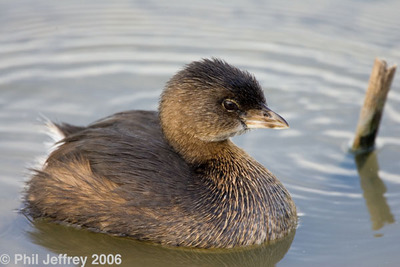
Pied-billed Grebe at Port Aransas
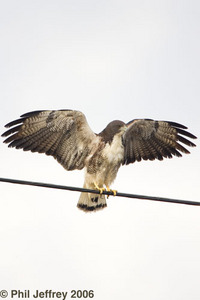 | The efficient ferry over Aransas Pass was not busy even at 8am - a Brown Pelican was perched on the pilings. Driving toward the Rockport peninsula I passed a White-tailed Hawk on a wire eating a snake and pulled quickly into Lighthouse Park to snap a few pictures of it - seemed to be a second year immature, but relatively tame. The causeway between Corpus and Padre Island and Aransas Pass and Mustang Island look like good places for heron photography in the early mornings. Of course this particular morning the light was really bad. Two more White-tailed Hawks were seen along the route up the coast between Port Lavaca and Brazoria. |
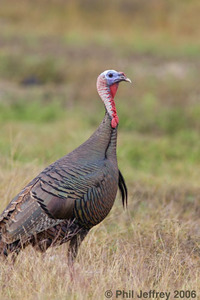 | I chugged north through Rockport, having lost that page of my map and unwilling to wander directionless around the peninsula. Eventually I made it over the bridge and headed north toward Aransas NWR. Taking FM-774 I passed a flock of Snow Geese and found Sandhill Cranes along with them. Down at Aransas NWR there were Wild Turkeys in the parking lot and courtesy of the wind and cool weather somewhat less than the traditional mosquito swarm. The helpful woman at the visitor center was classically Texan and justifiably proud of the record number of Whooping Cranes. Along the auto tour route Black-bellied Whistling Ducks were on the road in good numbers. Literally on the road, moving reluctantly out of my way as I edged past. At the observation tower it was not difficult to find two distant adult Whooping Cranes out in the marsh, apparently without a chick. Various herons, Caspian Terns, Redheads and Gadwall were also around. A Robin flock surrounded the tower and I finally saw a White-eyed Vireo. Returning along the road toward the visitor center the Whistling-Ducks were back on the road. A raft of ducks in the bay contained mainly Northern Pintails, some Redheads and two Canada Geese (not Cackling) apparently of some relatively large subspecies. |
Leaving Aransas, there were White Pelicans heading inland from the bay, near Austwell. I drove north on 35 through Port Lavaca and Palacios then switched to 521 (following the birding trail route). Around Tin Top I saw my first American Crows of the trip, and then it started raining. By the time I got to Brazoria on 521 it was raining relatively hard, but nevertheless I cut south to Freeport and then up 523 toward Brazoria NWR. At Brazoria NWR there was a Wilson's Snipe at the information center in the rain on the grass edge of the road. A full selection of herons, including Reddish Egret, were to be found in the various ponds. However goose flocks were relatively few and far between - some Snow Geese and Greater White-fronted were at the overlook near the turn-around. Also there was an American Bittern. Elsewhere on the route I found a couple of Sedge Wrens and a Swamp Sparrow. Mosquitos were very aggressive and the rain made it tough to bird.
After Brazoria I decided there wasn't enough daylight to consider doing the barrier beach trip up via Galveston toward Anahuac - this killed any prospect of doing Bolivar beach or Rollover Pass on this trip. So I turned inland and blasted toward Attwater Prairie Chicken NWR. Another couple of White-tailed Hawks were doing their Northern Harrier impersonations (gliding slowly over the fields with up-tilted wings) en route. After some fairly swift driving hampered by school buses, I ended up at Attwater Prairie Chicken NWR near Eagle Lake with about 20 minutes of daylight left. Concentrating on the Pipit Trail I came up with Savannah, Vesper, White-crowned and Field Sparrows. I also flushed a small group of Northern Bobwhite. What may have been a pipit flushed off the grass, but the light was so poor at this stage that it was unidentifiable (but call, flight style seemed to fit).
After it was fully dark at Attwater I headed north to Sealy and west toward Houston on I-10, where I stayed at a Motel6 near highway 6 at the western edge of Houston.
Exiting Katy Prairie via Brookshire I returned to Attwater Prairie Chicken NWR and walked the Pipit Trail. Savannah Sparrows abounded, but fairly soon I inadvertently flushed a Sprague's Pipit from the path and was able to then cautiously approach it with good scope views before retreating and leaving it to feed. A second one flushed from the prairie adjacent to the trail as I returned to the car. Field Sparrows and White-crowned Sparrows were singing intermittently. On the auto trail the waterfowl were being harassed by a Peregrine (mostly Blue-winged Teal and Northern Pintail but also American Wigeon, Northern Shoveler, Gadwall, Lesser Scaup, Bufflehead). Snow Geese and Greater White-fronted Geese flew over - several large flocks were in the general area of Attwater but I did not pursue them for lack of time. White and White-faced Ibis passed over and a few herons were around (Great Egret, Great Blue Heron mostly). The rest of the auto tour was mostly disappointing with the only sparrows being Savannah and the usual Eastern Meadowlarks and Loggerhead Shrikes.
Since I finished with Attwater so early (11:30am) I decided that I could make it to Anahuac, all the way over on the far side of Houston, and back to the airport in time. I ended up driving through the center of Houston on I-10 and down to Anahuac NWR in about two hours. I checked the rice field section about 7 miles east of the main entrance but it contained a few shorebirds (Least Sandpiper, Long-billed Dowitcher etc). A goose flock was too far from the road to scope (and obscured) so I returned to the main section of Anahuac. A flock of Snow/Greater White-fronted Geese were at the start of the auto trail that leads to The Willows. There were no Canada/Cackling in this flock. Around the Shoveler Pond route the herons (all major types except Green) were easily spooked from the banks. Double-crested and Neotropic Cormorants were common. There were two Cinnamon Teals at the overlook as well as Green-winged and Blue-winged Teals and Northern Shoveler. Roseate Spoonbills and Pied-billed Grebes were fairly numerous also. Apart from the inevitable Savannah Sparrows, passerines were relatively few and far between. I saw no other birders during my entire time at Anahuac. Exiting the Shoveler Pond section the flooded field held a few other shorebirds like Greater Yellowlegs and Black-bellied Plover but with strong backlighting some other IDs would have taken a disproportionate amount of time. After about an hour at Anahuac I decided I'd got about as much as I could out of it in the short time allotted, packed up the car and left for the airport - although I was dismayed to find that the north-east portion of Loop Rd 8 still held several traffic lights and did not turn into freeway until US-59 (right near the airport). It's about 90 minutes from Anahuac to the airport because of that and traffic on I-10.
Anahuac NWR with a series of impoundments and also some trees for migrating land-birds.
High Island/Smith Woods has the reputation as a major migrant trap.
Rollover Pass - good for herons and gulls/terns.
Bolivar Flats - extensive shorebird habitat.
Brazos Bend State Park usually most noteworthy for herons and perhaps Prothonotary Warbler, also allegedly has sparrows along the entrance rd (but pulloffs are difficult and this is a popular park). Least Grebe was reported from here in late 2006.
Aransas NWR for Whooping Cranes and abundant mosquitos. The Rockport Skimmer out of Rockport and Port Aransas does water-based tours which often make it easier to see the Cranes although you can usually see two adults from the observation tower. There are other companies offering such tours.
Kickapoo Cavern State Park (limited access) for Black-capped Vireo - Kerr WMA seems a better option.
Kerr WMA for Black-capped Vireo. The Kerr WMA is located about 80 miles northwest of San Antonio, in Kerr County at the headwaters of the North Fork of the Guadalupe River. Take IH 10 to Kerrville and turn west (south) on SH 16 and connect with SH 27 on the south side of Kerrville. Turn right on SH 27 heading toward Ingram about seven miles. In Ingram connect to SH 39 going west another seven miles to Hunt. Hunt is located to the west (right side) of highway 39. Go through Hunt on RR 1340 heading northwest for 12 miles to the Kerr WMA entrance. Looks to be ~20 miles due north of Lost Maples. Black-capped Vireo (look at this population trend data).
Lost Maples State Park, notably a good site for Golden-cheeked Warbler and allegedly Green Kingfisher, but a little limited beyond that. The park is located 5 miles north of Vanderpool on Ranch Road 187. Open 7 days, no gate, but modest fee.
10 miles north of Raymondville is El Canelo Ranch turn west down the dusty entrance road and then north again into the ranch itself. Ferruginous Pygmy Owl largely guaranteed. $150/night single occupancy, but then again there's that owl..... Also $35 per half-day of birding, probably by appointment only. 956-689-5042
South Padre Island Convention Center. Nature trails 7 days, no specific hours, free. various Rails, Franklin's Gull. The south bay section has breeding Mangrove subspecies of the Yellow Warbler but is accessible via boat only, apparently.
Laguna Atascosa NWR Sunrise-sunset/7 days. An Aplomado Falcon reintroduction site but hasn't been memorable for anything else when I've been there in previous years at least in part due to drought. Seems to be much wetter in 2006. From Harlingen, go east on Highway 106 14 miles past Rio Hondo. Take a left at the T and drive 3 miles to the visitor center. From South Padre Island, take Highway 100 out of Port Isabel and exit right on Farm Road 510 at Laguna Vista. Continue 5.4 miles to the Cameron County Airport road. Take a right and continue approximately 7 miles to the visitor center. From Brownsville, go north on Paredes Line Road (1847) through Los Fresnos to Highway 106. Take a right and go approximately 10 miles to the T. Take a left and drive 3 miles to the visitor center. Sprague's Pipit and Long-billed Curlew from Oct/Nov reports - I found the curlews.
Sabal Palm refuge for the usual suspects including Buff-breasted Hummingbird, White-tipped Dove, Long-billed Thrasher, Plain Chachalaca, Least Grebe and more. Visitor Center open 9am-5pm daily, trails open year-round 7am to 5pm. $5. Link to trail map. From US 77/83 go east on Boca Chica past the airport. Turn right (south) on FM 511. At the four way stop continue straight on FM 3068 until it ends at Southmost and turn right. Go 1/2 mile to the entrance on the left. The visitor center feeders were very quiet in Nov 2006 when I was there, but the resaca was still productive.
Brownsville's Fort Brown for Green Parakeet. Tropical Kingbird has apparently been at the golf course nearby. No recent reports from this vicinity, it's still good for the Parakeets in Nov 2006. The parrots appear to be more of a neighborhood Brownsville location rather than the fort itself - and I was unable to find good Red-crowned Parrot locations on this trip. Not sure what restrictions there are on visiting the golf course, which is a little east of Fort Brown.
Brownsville: north on 4 then south on 511 (Indiana Ave) to Utah Rd for Tamaulipas Crow (April 2005) at n.e. corner of airport. - this doesn't apply during winter months when they appear to drift south of the border.
Old Port Isabel Rd for Aplomado Falcon, Cassin's Sparrow - no recent Aplomado Falcon reports from there, although there may be some at Laguna Atascosa - infrequent reports are seen from there but with no specific locations it's very much hit-and-miss.
Resaca de la Palma State Park (WBC site) on west side of Brownsville. Currently the main entrance to Resaca de la Palma State Park is off of Military Highway 281. The existing park entrance is located 4 miles west of Brownsville along Highway 281. It lies due North of River Bend Golf Course and Resort. Apparently by appointment only.
Los Ebanos Preserve in San Benito. 6 days a week from 8AM to 5PM closed Thursdays. $5. Private and not part of the World Birding Center cluster. On State Hwy 100 between Harlingen and Brownsville, Texas. From Expressway 77/83, take the South Padre Island exit and go east 100 yards to our entrance on the left.
Harlingen Arroyo Colorado Sunrise-sunset 7 days. Free. Take Expressway 83 to Ed Carey Dr. Exit on to Ed Carey Dr. Travel North on Ed Carey Dr. until you come to Arroyo Colorado site on the east side of the road. May be a good site for Green and Ringed Kingfisher but few reports seen from there.
Estero Llano Grande State Park in Weslaco. 8am-5pm during Nov-Apr, closed Mondays ($3). May-Oct also closed Tues. Green Kingfisher has been reliable, Red-crowned Parrot reported, Northern Jacana was there Aug-Oct. Groove-billed Ani reported in Jan 2007. Take Expressway 83 to FM 1015. Travel South on FM 1015 crossing Business 83 and Mile 6 North. Look for the World Birding Center entrance on the east side of FM 1015 before reaching Mile 5 North (at the point where the road curves right if you are headed south from US-83). It should be possible to navigate back roads between Estero Llano and Frontera Audubon if you have a better map than I did - E 18th St looks like a good bet.
Weslaco Valley Nature Center ($3). Closed Mon. Tue-Fri: 9am-5pm, Sat: 8am-5pm, Sun: 1pm-5pm. In Gibson Park - 1 block south of Business 83 on Border Street in Weslaco. Road construction: from west take Milano St/Westgate temp exit and then frontage road; from east take Airport Dr/Texas Blvd then south on Texas Blvd to Business-83 west. Either way take Border Ave south of Bus-83 for 1.5 blocks. This seems to be of marginal interest since it is very urban and lacks much habitat.
Frontera Audubon site in Weslaco. Green Kingfisher on 2/18. 1101 South Texas Blvd, Weslaco several blocks south of 83 near 12th St. S Texas Blvd is "Mile 5 Rd W" coming from US-281. Open 7 days (Sat best). Sun-Fri 8-4pm, Sat 7am-7pm. Weslaco is about 17 miles west of the US-83/US-77 junction in Harlingen. This is a relatively small site in suburban Weslaco, nevertheless has a good selection of species.
Edinburg Wetlands World Birding Center in Edinburg (WBC site), also now have their own web site as of Dec 2006. Trails Sunset-sunrise/7 days. $2. Take Rt-83 to North Highway 281. Travel north on Highway 281 to the University Dr. exit. Travel east on University Dr. until Raul Longoria St. Turn south on Raul Longoria to Sprague St. Travel east on Sprague St. until you reach Edinburg Scenic Wetlands on your left. I've not been to this site.
Santa Ana NWR (also Wiki link here). Refuge headquarters is located 7 miles south of Alamo, Texas, on FM 907 about 1/4 mile east on U.S. Highway 281. Trails open 7 days sunrise-sunset. This is a little east of McAllen. Clay-colored Robin and Tropical Parula have been my main finds here, historically. It's still a must-visit on any RGV trip.
Allen Williams residence, $10 Fee. Directions: 750 Sam Houston Ave., Pharr, TX. From McAllen: exit Expressway 83 at Jackson Rd. Follow Jackson Road south to its intersection with Jackson Avenue. Eastward Jackson Avenue becomes W. Sam Houston. Turn east onto Houston and continue to 750, which is on the north side of the street between the Senior Friends Fitness Center and the Skinner/Silva Funeral Home. This appears to be south-west of the US-83/Rt-281 intersection. At one point a big rarity magnet, this didn't seem to be the case in Nov 2006 - I wasn't seeing any reports from there whatsoever.
Quinta Mazatlan in downtown McAllen - Weds-Sat 8-5pm, Tues 8-8pm, Sun/Mon closed. $2. Take Expressway 83 to 10th Street exit. Travel South on 10th St. Turn East on Sunset (Wyndham Garden Hotel on corner). Proceed along Sunset to Quinta Mazatlan with parking lot out in front of the big brown gates.
McAllen sewage ponds: shorebirds, waders, ducks. From McAllen go south on 115 towards Hidalgo. Turn right (west) on Idela Drive and follow it until it ends. This is just a little south of the airport and on the west side of 115 - it was CLOSED ON SUNDAY when I went there and in fact the birding access wasn't clearly marked so it's status is uncertain even if it is on the birding trail maps.
McAllen Green Parakeets as of 12/05 they are staging at 10th and Dove which is several blocks north of the previous Hastings Bookstore location. Supposedly they are still in this general area - looks to be perhaps 5 miles north of US-83, with alternative (faster?) access via US-281 exiting at Owassa Rd (which seems to be what Dove becomes).
Anzalduas County Park. Mission. Fee on weekends. Opens 8am-sunset. From US 83 west of Mission follow FM 1016 south about 5 miles, then right on FM 494 (look for sign to park). (Alternative: exit S Shary Rd/494 from US-83). Near Granejo. Historically - Vermilion Flycatcher, Tropical Parula have been my main finds here. Also good for Gray Hawk, Spragues Pipit (2/18/06), NB Tyrranulet. I did not visit it in 2006, for pressure of time.
Bentsen-RGV is open 6am-10pm/7 days. $5. This site is radically changed since they banned RV camping, so it's a question how good it remains - I've spoken to some birders who are fairly negative about the "revisions", although doubtless this is not the only viewpoint. Activity was fairly low there in Nov 2006, but this may have been seasonal and the fact that it is a wet year. Either way, the experience there will no longer be as distinctive as it was on my 2000-2002 visits. Having said that, few could argue with Northern Beardless-Tyrannulet, Gray Hawk and Clay-colored Robin unless they were familiar with the old Bentsen (which was often even more productive, with better views).
Nature Conservancy's Chihuahua Woods - web page lists it as currently closed due to fire danger, but it has said that from Mar-Nov 2006 so who knows if they've forgotten to update the site. Normally sunrise-sunset. 956/580-4241. US-83 west of Mission to Goodwin Road/FM 492 exit (at H.E.B. Food Store). Turn left (south) onto FM 492 and go about 1 mile to Business 83 (at blinking light). Turn right (west) onto Business 83 and go about 0.8 miles toward where the road curves northwestward. At the curve, go straight onto blacktop road parallel to the railroad track for about 0.1 miles. Preserve entrance is on the left, where the blacktop road crosses the railroad track.
La Sal de Rey tract: North on US 281 to the intersection of TX 186. Go east on TX 186 to USFWS La Sal del Rey tract of LRGVNWR. In winter, Lark Buntings along the shoulders of TX 186. A public information map of this tract is posted 2.3 miles west of Brushline Rd. on TX 186 near the GTCBT site sign. Entry points are off of TX 186, Chapa Rd., Brushline Rd., and an unnamed dirt road that T's into Brushline Rd. An extensive network of trails east of Brushline Rd. A map indicating access points may be obtained from the Santa Ana NWR HQ. In winter, pre-dawn at the public information spot on TX 186 - early morning exodus of roosting Sandhill Cranes (4-10K), Snow Geese (100-10K), up to 3K Long-billed Curlews (they leave while it is still dark). At dusk, at the northernmost entry site on Brushline Rd. and hike to the lake where you'll be able to see curlews, cranes and geese return, silhouetted against the sunset over the lake. Also good for wintering Say's Phoebes. White-tailed Hawk, Crested Caracara etc year-round.
Roma Bluffs is on the south-west side of Roma and appears to just be an overlook rather than a good site (although there are a lot of birds on the checklist, which may be more "theoretical"). Take US-83 Business to downtown Roma. At the intersection of US-83 Business and Lincoln Ave. turn West onto Lincoln Ave. Travel West to the intersection of Lincoln Ave. and Portscheller. Take Portscheller South to Convent. The World Birding Center is located on the Southeast corner of the intersection of Portscheller and Convent. There are brown signs along US-83 pointing to the turn off in the older western part of Roma.
Santa Margarita Ranch - not found specific online info on this site, but is on the river access to the south of Salineno - TX birding trails maps contain the relevant info.
Salineno - DeWind's usually depart at the end of March, appear to have arrived as of mid Nov 2006 - was quiet in Nov 2006 but did have Audbon's and Altamira Oriole.
El Rio RV Park at Chapeno - still feeding the Brown Jays (7am and 11am as per Wiki), no reports of the Jays as of 11/06 - in fact at that time they were nowhere to be found along the TX side of the Rio Grande, however they started appearing at Chapeno in late Dec 2006.
San Ygnacio Bird Sanctuary: At end of Washington street in San Ygnacio. Joel Ruiz, curator San Ygnacio Bird and Butterfly Sanctuary; TX Lower Coast Birding Trail # 87, P.O. Box 100; San Ygnacio, TX 78067 Tel. 956-765-8468. datlax@sc2000.net. White-collared Seedeater at the end of the Raptor Trail by the San Ygnaico RV Park's Boat Ramp on some of their favorite grasses that were not damaged. (very elusive as of 11/06)
Le Conte's Sparrows (from 2001): on the UTC, the fields before the entrance station at Brazos Bend State Park and Yellow Rail Prairie at Anahuac NWR might be your best bets. In fact I got better directions for Morrison Rd on Katy Prairie, where I actually saw two. You should also try the fields on the north side of Gummert Road in west Harris County. Go north on Barker-Cypress from I-10 west of Houston. Turn left onto Old Greenhouse Road (after 2 lights), then go straight onto Gummert when Old Greenhouse turns left. The dry grass fields on the north side of the road have had Le Conte's.
And Greg Lavaty's Le Conte's advice from 2006 via private email: "Along Morrison Rd and near Eldridge Rd at the Addick's Reservoir. To get to Morrison Rd you will take I-10 west and exit at Pederson Road. Go north on Pederson until you reach SH 90 and turn left onto SH 90. Proceed west on 90 a short distance until you reach 2855 and turn right (north). Take 2855 north for several miles until you reach 529. You will notice as you cross 529 that 2855 diminishes in quality quite a bit. Proceed to the end of 2855 where you are forced to turn left (I believe you could turn right but there is a gate in the way). At this point you are on Morrison Rd. This is the place where you want to search for the LeConte's Sparrows. I usually drive very slowly along Morrison looking and listening and occasionally stopping to pish. If it isn't windy you should be able to find the LeConte's without much trouble. I would suggest proceeding down Morrison until you reach Pattison Rd. Turn north on Pattison and again you will be in the middle of excellent habitat for the sparrows. Continue north until you reach Hebert Road and turn left. You will find some hedge-rows here which are usually good for sparrows. This is the best place that I know of to find Harris's Sparrows. The other option which is closer to town would be Eldridge. "
From TEXBIRDS: "In monitoring the explosive expansion of Tropical Kingbird in south Texas I have found a near 100% habitat segregation between these two virtually identical species. Indeed, I find that looking at the habitat in which a given bird is found is a 95% accurate predictor of its identity when the bird vocalizes. Tropicals inhabit open areas with mostly shorter and especially more widely spaced trees and shrubs. There is usually a fresh water source within immediate area. Golf courses and similar terrain constitute typical Tropical Kingbird habitat. Couch's Kingbirds are found in areas with taller, and especially more closely spaced trees. The presence of surface water is not required, though some territories do have this feature. My guess is that this habitat segregation does not reflect preferred habitat as much as it reflects competition between two species whose niche is very similar. I suspect that the numerically dominant Couch's Kingbird forces Tropicals into somewhat marginal habitats." - this conclusion seems to have been echo'd by subsequent posts to TEXBIRDS e.g. for Quinta Mazatlan.
In Port Aransas Texas, arriving from the ferry (from TEXBIRDS in 2002):
"Leave the ferry and turn right at the first intersection ( Circle K
Store ) and you are now on the "Cutoff" Road. It is poorly marked with
few street signs.
Go ~.3 mi on the cutoff road , and turn right just past the; old
Paradise Motel. Drive down a new paved driveway to a small parking lot.
The driveway will be bordered by a new fence next to the motel.
Park and follow the new sidewalk to arrive at the boardwalk which goes
out over a willow covered swampy area. I believe the area is from
runoff from the motel. Anyway, It is one of the few areas with real
trees on Port Aransas and attracts the migrants. The new boardwalk has
three large viewing areas with plenty of room. Photographers can get
great close-ups ( with dark backgrounds ) of warblers, waterthrushes,
etc."
From Feb 13th 2006: "Tropical Kingbird - a pair at the extreme south tip of the Ft. Brown Golf Course in Brownsville. These birds wandered around on the course, but sang fairly often so they were easy to relocate. Gray-crowned Yellowthroat - 1 or 2 birds in the grassy margin between me and the Kingbirds. This spot is aobut 20 yards east of a Golf Course refuse dump (on the dirt road that circles the course)."
Yellow Rail (on the prairie) and King Rail at Anahuac NWR on March 8th 2006.
From March 9th 2006: "Red-crowned Parrots and Green Parakeets ahve been present the past several mornings at 7:30 AM at the corner of Oklahoma and 11th Street in Weslaco about four blocks west of Frontera Audubon Thicket. The Red-crowned Parrots leave early and sometimes are back about 6PM. The Green Parakeets fly over frequently during the day." - personally by best place for Green Parakeets remains Fort Brown in Brownsville.
Red-crowned Parrot: In Brownsville, look for parrots in the general vicinity of Honeydale and Los Ebanos Streets; in Harlingen at the K-Mart near the intersection of Morgan and Grimes Streets; in McAllen on the east end of Dallas Ave (near Mockingbird St). Best times are at dawn and dusk Red-crowned Parrots at around 0700 in the neighborhood across 88 from Frontera Audubon, Weslaco and around the Valley Nature Center late in the day.
early 2006: Green Parakeets at 10th/Dove or 10th/Violet in McAllen, a bit before 1700. Also Fort Brown in Brownsville.
The Thayer's Gull that was found on Nov. 10 (2006) was still on the beach near marker 96 between Port Aransas and Corpus Christi on Nov. 13 and 15. The bird is an adult.
California Gull on Bolivar flats on Nov 18-19th (2006), also at Flour Bluffs south of Corpus Christi on Nov 21st.
11/19/06: "The area at the end of Indian Beach Drive is quite birdy, with many Sedge, Marsh and House Wrens, Palm Warblers, several species of sparrows, kinglets and other interesting songbirds." (Indian Beach Drive is south of Galveston on the barrier island, on the right (north) just past Galveston Island State Park but before San Luis(?) pass.
On the Upper Texas Coast a RED PHALAROPE was found in Jefferson County on Saturday, November 18 2006. The bird was still present 11/21. The bird was in a flooded field off of McDermond Road, which is off of FM 365. This is west of Fannett.
Santa Ana NWR for Nov 2006: "The Clay-colored Robin is being seen at the start of trail B and we had a Northern-beardless Tyrannulet near the new hawk tower".
11/22/06: "the White-Collared Seedeaters have started to show themselves more. This morning at 0925 and when I left at 0933, there were a male and female in the Carrizo(cane) across from the observation platform and in the back towards the river, I could hear two more calling; but no visual. The males are not yet singing."